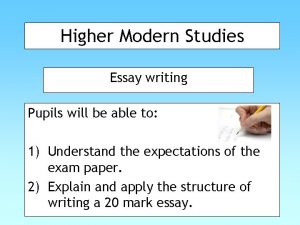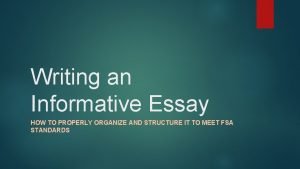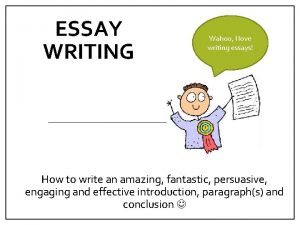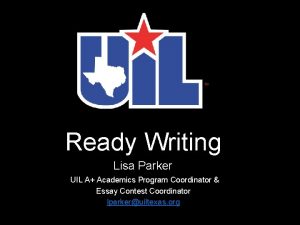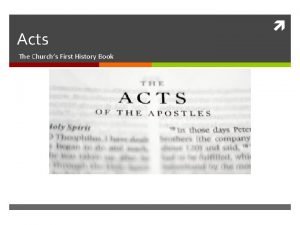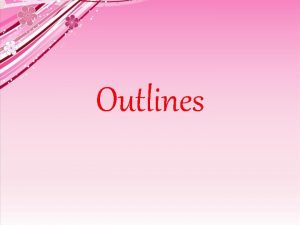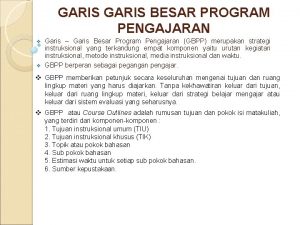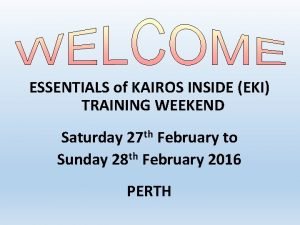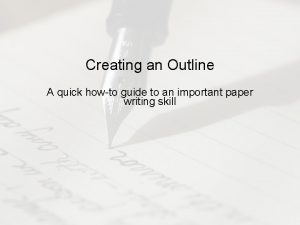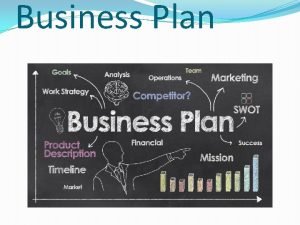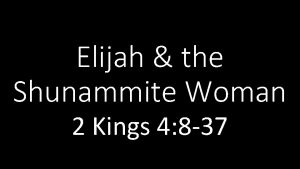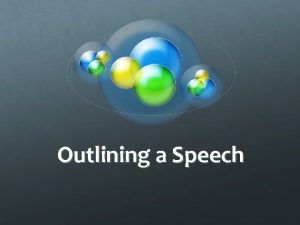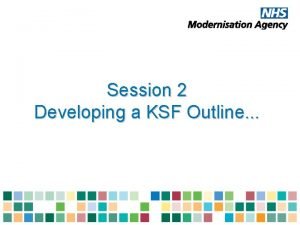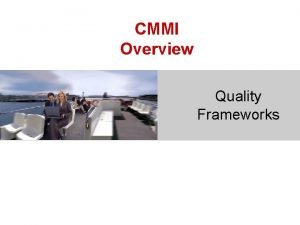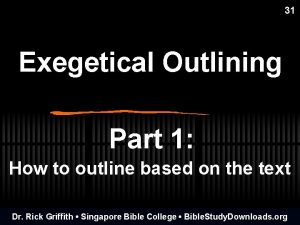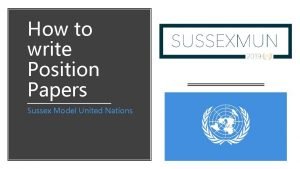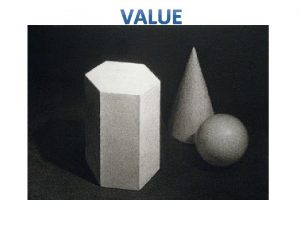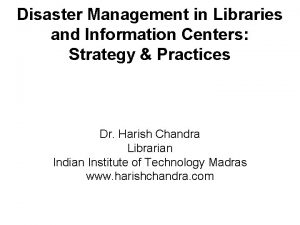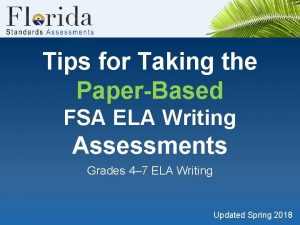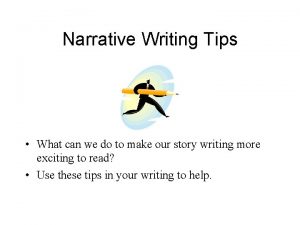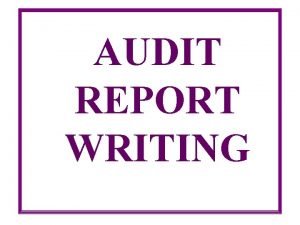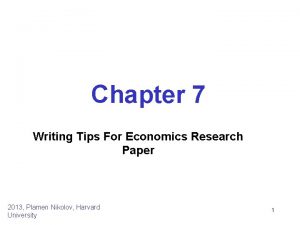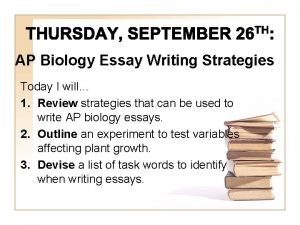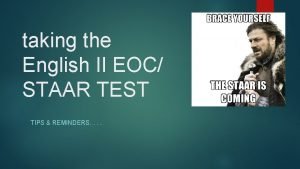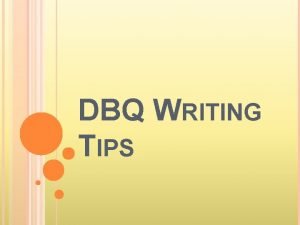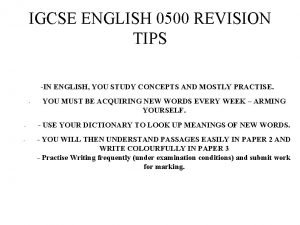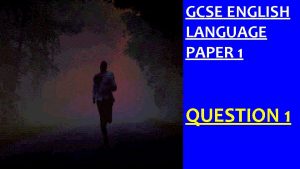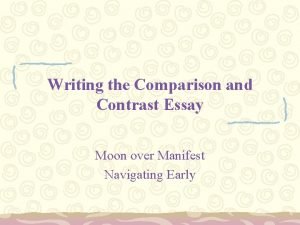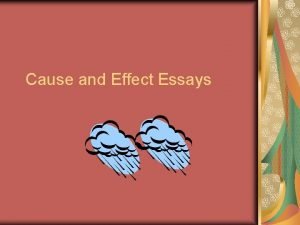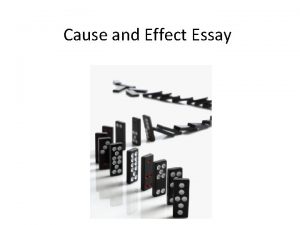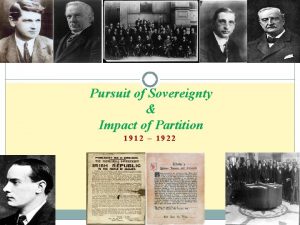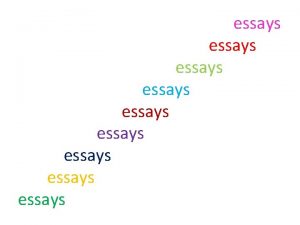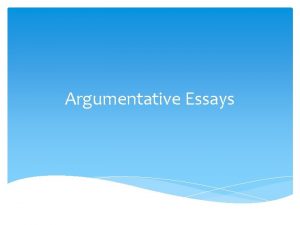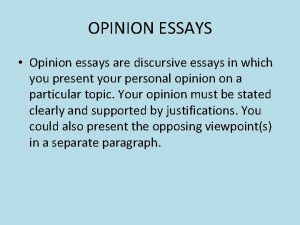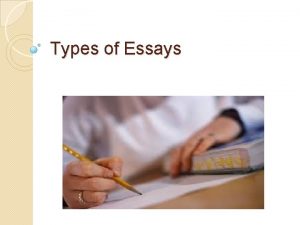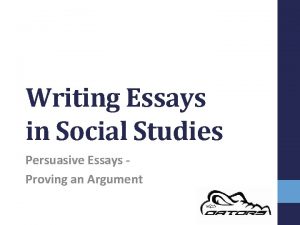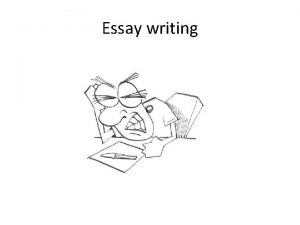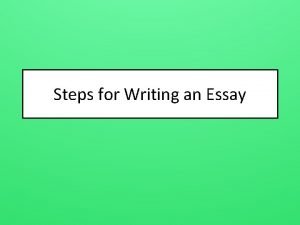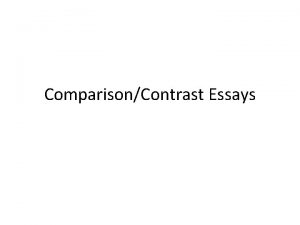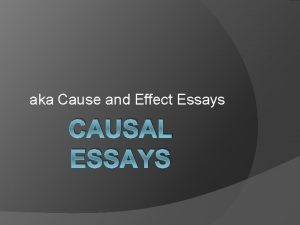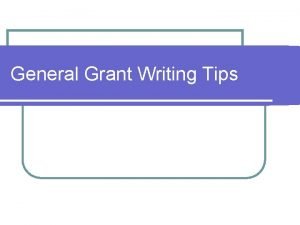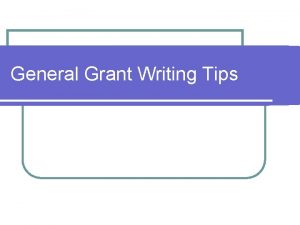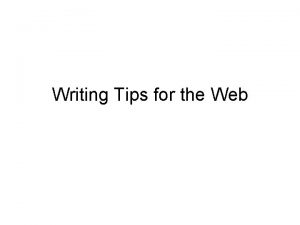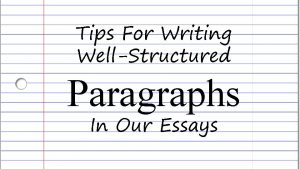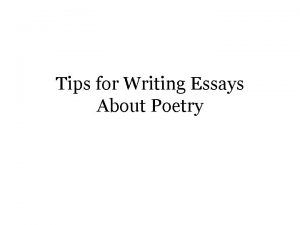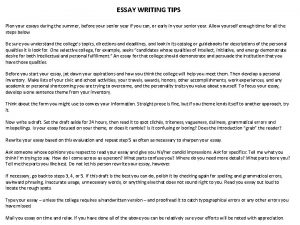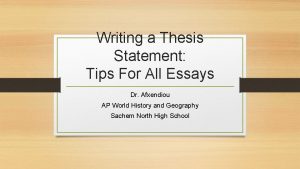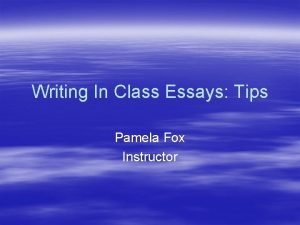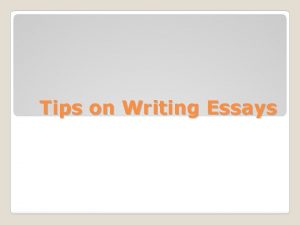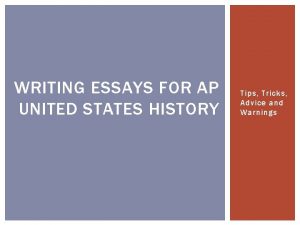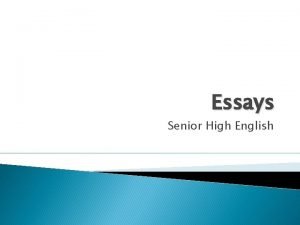Tips for writing outlines and essays Modern Language













































- Slides: 45

Tips for writing outlines and essays Modern Language Association (MLA) format

Modern Language Association (MLA) Use Times New Roman, 12 -point font. Double space (CTRL 2) Allow one-inch margins In “Paragraph” tab, change After Spacing to 0 pt. Surname in right HEADER.

Modern Language Association (MLA) Click Insert Page Number Top of Page Plain Number 3 Type your surname. Hit the SPACE bar. Ctrl A (to select all) and change font to Times New Roman 12 -point Close Header.

Modern Language Association (MLA) OUT of the Header and on the left type: Name Professor Class Due Date Class Meeting Time

Modern Language Association (MLA) When you read outside sources, you must include in-text citations. Use “quotation marks” around information you take word-for-word from a source. Cite information from sources, even when you paraphrase.

Modern Language Association (MLA) In-text citations are necessary for directly quoted AND paraphrased information. Place citations directly after the sentence(s) that contain the research. ALL in-text cited sources MUST be listed on the Works Cited Page.

Love is a perplexing paradox. As a little girl, I read stories of Cinderella and Snow White and imagined a handsome man appearing with a rose to woo me and carry me away to bliss. I never paused to consider any drawbacks to this fantasy, and have subsequently discovered how vexing love is. I now can denote “a thousand errors” in my husband, just as the narrator of Shakespeare’s Sonnet 141 indicates. But, like his narrator, “. . . ’tis my heart that loves what they despise/ Who in despite of view is pleased to dote” (ll. 3 -4). Love traps me with invisible fencing and sometimes knocks me off my feet with its spark. I am reminded of its force and, as Rebecca Ferguson says, “. . . nothing’s real but love/no money, no house, no car/ can beat love. . . ” (“Nothing’s Real but Love”).

Modern Language Association (MLA) Works Cited Ferguson, Rebecca. “Nothing’s Real but Love. ” Heaven. 2011. Shakespeare, William. “Sonnet 141. ” Ten Things I Hate About You. Dir. Gil Junger. Perf. Julia Stiles, Heath Ledger, Joseph Gordon-Levitt, David Krumholtz. Dis. Touchstone Pictures, 1999.

Modern Language Association (MLA) The Works Cited page should begin on the next page after the essay ends (even if the essay doesn’t take up all of the preceding page). Hit ENTER(or insert page break) until your cursor gets to a new page.

Modern Language Association (MLA) The exact title “Works Cited” should be centered at the top of the page. Hit ENTER, then back space to left align your cursor again. List sources alphabetically. The first line of a source’s information should be left aligned.

Modern Language Association (MLA) Information that does not fit on the first line should be tabbed over once. *Type in all the information first. Then place your cursor at the beginning of the second line. Hit ENTER(you won’t see anything happen).

Modern Language Association (MLA) Then hit TAB. When you ENTER again for a new source, hit the BACKSPACE bar once. To cite Internet sources, give as many items IN THIS ORDER that you can find:

Modern Language Association (MLA) Author, Article Title, Online Database, Date published or last updated, # of paragraphs in article, Date procured from Web, Web address (but you must remove the hyperlink)

Modern Language Association (MLA) Works Cited Bedingfield, Natasha. “These Words. ” Unwritten. 5 October 2004. Shakespeare, William. “Sonnet 141. ” Ten Things I Hate About You. Dir. Gil Junger. Act. Julia Stiles, Heath Ledger, Joseph Gordon-Levitt, David Krumholtz. Dis. Touchstone Pictures. March 31, 1999. 99 minutes.

Modern Language Association (MLA) Be mindful of specific punctuation and spelling. For assistance, visit http: //owl. english. purdue. edu/owl/resource /747/01/ Specifically for Internet sources visit http: //owl. english. purdue. edu/owl/resource /747/08/

Tips for Pre-Writing Creating an outline is a powerful prewriting tool. It acts like a blueprint or scaffold for any essay. See page 279 in The Writer’s World textbook for a sample.

Tips for Pre-Writing Below the meeting time type “Thesis: ” along with your statement. Below this, begin your outline with Roman numeral I. This is the first main point that proves or defends your thesis statement.

Tips for Pre-Writing Under I, you need A, B, C. These are three examples that prove or defend the first main point which proves or defends thesis. Continue to Roman numeral II, which is the second main point that proves or defends thesis.

Tips for Pre-Writing Under II, you need A, B, C. These are three examples that prove or defend the second main point which proves or defends thesis statement. Continue to Roman numeral III, which is the third main point that proves or defends thesis.

Tips for Pre-Writing Under III, you need A, B, C. These are three examples that prove or defend the third main point which proves or defends thesis. You do not need include the introduction or the conclusion in the outline- only body paragraphs.

Tips for Pre-Writing When you use research for the essay, the outline MUST also include in-text citations. Be sure to use “quotation marks” around information you take word-forword from a source. Cite all information from sources, even that which you paraphrase.

Tips for Pre-Writing In-text citations are necessary for directly quoted AND paraphrased information. Place citations directly after the sentence(s) that contain the research. ALL in-text cited sources MUST be listed on the Works Cited Page.

Tips for Pre-Writing Works Cited “House of Plantagenet. ” Wikipedia. (25 SEP 2011): 37. 26 SEP 11. <http: //en. wikipedia. org/wiki/Plantagenet>. “Wars of the Roses. ” Wikipedia. (25 SEP 2011): 78. 26 SEP 11. <http: //en. wikipedia. org/wiki/Wars_of_the_Roses>.

Tips for Writing Essays I. Paragraph (¶) #1: Introduction A. Hook the readers with a powerful, interesting statement about the topic B. Suggest valid points C. State thesis (provable point) and supporting points.

Tips for Writing Essays Remember these tips: ◦ Thesis must be a complete sentence. ◦ Thesis must have a controlling idea. ◦ Thesis must be expandable for an essay. ◦ Thesis must make a valid and interesting point.

Tips for Writing Essays Remember these tips: ◦ Avoid being vague: Love is big problem. ◦ Avoid being obvious: Love is important. ◦ Avoid being invalid: Love never changes.

Tips for Writing Essays Remember these tips: ◦ Pre-write to determine supporting points. ◦ Choose points/ideas that support thesis statement. ◦ Be sure that supporting points prove thesis statement.

Tips for Writing Essays II. ¶#2: 1 st body ¶ A. Provide transition* to previous paragraph B. Explain point #1 by giving three examples that prove this main point C. Paraphrase main point and provide ending transition*

Tips for Writing Essays Provide transitions between paragraphs. These should appear at both the beginning and the end of each paragraph.

Transcendent Transitions Although Hence Furthermore Even though Over all Secondly However Thus Lastly Finally Next First Nevertheless Following that In the end Not only Besides In regards to As a result Obviously Clearly As a whole Subsequently In addition to Additionally In juxtaposition to Adjacent to Arbitrarily Also In opposition to As opposed to

Tips for Writing Essays III. ¶#3: 2 nd body ¶ A. Provide transition* to previous paragraph B. Explain point #2 by giving three examples that prove this main point C. Paraphrase main point and provide ending transition*

Tips for Writing Essays IV. ¶#4: 3 rd body ¶ A. Provide transition* to previous paragraph B. Explain point #3 by giving three examples that prove this main point C. Paraphrase main point and provide ending transition*

Tips for Writing Essays V. ¶#5: Conclusion A. Provide transition* to all previous paragraphs B. Paraphrase all main points C. Paraphrase thesis

Tips for Writing Essays V. ¶#5: Conclusion (continued) D. End essay with a closing “hook” by writing a meaningful statement showing the great importance of this thesis or by giving the audience something on which to “chew, ” to ponder

Common Errors in Writing Writers often make the same mistakes, even seasoned writers! Remember that essays are written using formal, professional English. Essays should not sound like the way we speak to our friends or families.

Common Errors in Writing Don’t tell the audience what you (the writer) are going to say in your essay. JUST SAY IT. Eschew phrases like: ◦ “This essay will talk about. . . ” ◦ “I am going to show you. . . ”

Common Errors in Writing Eschew phrases like: ◦ “In conclusion. . . ” ◦ “I believe. . . ” OR “I think. . . ” ◦ “The book I read is. . . ” ◦ “My thesis is. . . ” ◦ “My first main point is. . . ”

Common Errors in Writing Do not use any form of the word “you. ” This is an arrogant way of viewing your (the writer’s) audience. The audience may not have had the same experiences or have the same perspectives as you.

Common Errors in Writing Share personal experiences by using first person (I, me, etc. ). Or share experiences using general pronouns like: someone, people, a person, an individual, many, etc.

Common Errors in Writing Check subject-verb agreement. ◦ I challenges my students. ◦ She assist the residents. ◦ Brittany and Ashley, who works at Dunkin’ Donuts and Cinnabon, creates decadent and delicious desserts.

Common Errors in Writing Check pronoun-antecedent agreement. Incorrect: ◦ A professor challenges their students. Correct: ◦ A professor challenges her students.

Common Errors in Writing Check pronoun-antecedent agreement. Incorrect: ◦ A person enjoys music. They listen to different music depending on their moods. Correct: ◦ People enjoy music. They listen to different music depending on their moods. .

Common Errors in Writing Do not use these words: thing anything everything something none no one always all neveryone

Common Errors in Writing Spell out numbers below 100 (excluding dates and times) Vary sentence structure Check the use of there, they’re, their Check the use of to, too, two

Common Errors in Writing Underline book titles, movie titles, TV shows, video games, magazines, CDs Use quotation marks around song titles, poems, chapters, magazine articles and TV episodes
 Evaluative language modern studies
Evaluative language modern studies Higher modern studies essay introduction examples
Higher modern studies essay introduction examples Aims and objectives in essay
Aims and objectives in essay Informative essay guide
Informative essay guide I love writing essays
I love writing essays Uil ready writing sample essays
Uil ready writing sample essays The book of acts outline
The book of acts outline Coordination outline
Coordination outline Outline learning objectives
Outline learning objectives Prison ministry training manual download
Prison ministry training manual download Commercial law outlines
Commercial law outlines Four main components for effective outlines
Four main components for effective outlines A business plan is a document that outlines
A business plan is a document that outlines Pyelonephritis
Pyelonephritis Sermon outlines on the shunammite woman
Sermon outlines on the shunammite woman Anime misconceptions
Anime misconceptions Two types of outlines
Two types of outlines A haunted house by virginia woolf characters
A haunted house by virginia woolf characters Ksf outlines
Ksf outlines Mucoepidermoid carcinoma pathology outlines
Mucoepidermoid carcinoma pathology outlines Cmmi model outlines
Cmmi model outlines Exegetical outline example
Exegetical outline example Cjis security awareness
Cjis security awareness Mun position paper outline
Mun position paper outline Define visible
Define visible Focal crypt abscess
Focal crypt abscess Disaster management in libraries and information centres
Disaster management in libraries and information centres Tips for fsa writing test
Tips for fsa writing test Narrative writing tips
Narrative writing tips What is the primary purpose of writing a lab report
What is the primary purpose of writing a lab report Writing tips for economics research papers
Writing tips for economics research papers Biology essay writing tips
Biology essay writing tips Staar english 2 2019 answer key
Staar english 2 2019 answer key Dbq tips
Dbq tips Igcse english tips
Igcse english tips Obed ramotswe paper
Obed ramotswe paper How to start a compare and contrast paragraph
How to start a compare and contrast paragraph Cause and effect essays topics
Cause and effect essays topics Cause and effect essay
Cause and effect essay Pursuit of sovereignty and impact of partition essays
Pursuit of sovereignty and impact of partition essays Formuö
Formuö Typiska drag för en novell
Typiska drag för en novell Tack för att ni lyssnade bild
Tack för att ni lyssnade bild Vad står k.r.å.k.a.n för
Vad står k.r.å.k.a.n för Varför kallas perioden 1918-1939 för mellankrigstiden
Varför kallas perioden 1918-1939 för mellankrigstiden En lathund för arbete med kontinuitetshantering
En lathund för arbete med kontinuitetshantering

